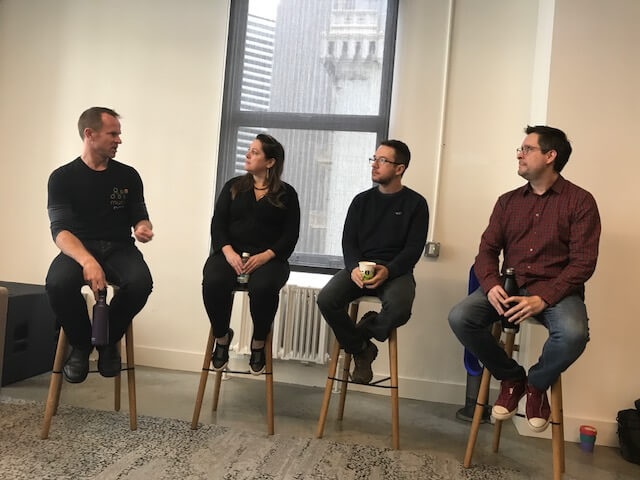101 Top Tips For Founders – From Investors We Met In The US.
Author: Superstar Bec Pham, Founder Experience Manager, muru-D
I’ve just had a completely awesome time drinking up the startup juice in Silicon Valley with our latest Sydney and Perth cohorts. Raising capital is on the minds of many founders and here are the top 101 tips from investors we met in the US. These individuals have had vast experience and invested in startups, scale-up companies and ambitious founders.
Quick note. Not all of these tips will apply to everyone. Filter through and absorb what makes the most sense to you and your business. We’ve been learning through many discussions that there’s no one secret sauce to raising funds or building your network. However, most of these pointers are suitable for conversational pitching.
When fundraising.
- Your job as CEO is to fundraise for the first 5 years of your startup
- Be fundraising all the time.
- But don’t tell anybody – particularly your employees because of point 5 below.
- Always have focus.
- Have your team focussed.
- Don’t let investors deviate your focus.
- Maintain your passion.
- You should have started closing investment 6 months ago.
- Don’t wait till you’re in the red zone to start raising.
- Focus on the customer journey at the angel stage.
- Pitch your hype OR your metrics. Don’t mix the two.
- Don’t run your business to fundraise. Fundraise to grow the business you want to run.
- Write your story for raising the next round, when you’re raising this round.
- Don’t burn bridges. It’s a small community and everyone talks to one another.
When pitching – Do
- Show your passion and vision whenever you pitch.
- Practice your elevator pitch. Explain what your company does in one sentence.
- If your market already has a dominant player, start your pitch with why you’re different.
- Back that up with traction.
- If you’re the similar to that dominant player, explain how you’re going to win the market.
- Introduce yourself and say your company name… S..L..O..W..L..Y and CONFIDENTLY
- Talk about your team.
- Be personal. Tell a story.
- Focus on getting investors engaged on your initial pitch – not the full detail.
- Pause in your pitch. Let people think and ask you questions.
- Test your pitch with junk investors (people you’d never actually have invest in your company) before you pitch to your ideal top investors.
- Leverage these investors to get connections.
- Refine your pitch everytime. Get feedback and learn from your mistakes.
- If you have a product, demo it.
- Wear your company t-shirt, hat, tattoo .
- It’s not just the perception of your business, it’s other things investors see – consider your competitor’s pitches.
- If you’re doing something new, address your TAM (Total addressable market)
- Same thing for a niche market.
- Drop impressive numbers where you can. (Some investors like numbers, some like stories, figure out which one you’re talking to)
- Get straight to the point. No beating around the bush.
- For a marketplace, explain both sides of the market succinctly. E.g. For businesses they get value in X and for consumers they get value in Y.
- Resonate with the investors.
- Use the term ‘purpose driven company’ accordingly. It doesn’t resonate with all investors.
- If you do use ‘purpose driven company’, explain your business model. Investors immediately associate you as a NFP (not for profit) otherwise.
When Pitching – Don’t - Don’t read off a script.
- Don’t use phrases like “we’re an uber for [insert your market]”.
- Don’t pitch too big that it sounds impossible.
- Don’t say “we’re disrupting ourselves”.
- Don’t forget to explain WHAT you do.
- Don’t offer how long you’ve been running for in your initial pitch.
- Don’t say you’ve been running your company for 5+ years.
- Don’t mention government or city councils in your pitch. Selling to government appears frightening and slow to investors.
- Saying you’re selling to enterprise is worse than government.
- Avoid the use of the word ‘and’ or ‘or’ too much in your pitch. It’ll confuse people.
- Don’t anticipate your investors questions. Share your story and let the questions come.
- Who is your customer? Don’t say “everyone”. When talking to / communicating with investors.
- Lead with asking what their investment criteria is. This is often the deal-breaker.
- When you’re doing seed rounds, try to meet Series A and B investors too.
- Add them to your investor mailing list and keep them updated along with your actual investors. Investors are thinking “If you’re not communicating before you get my money, you’re not going to communicate after you get my money.”
- Update your investors (or potential investors) at least quarterly.
- This also helps speed up your next round.
- Always tell the truth. Don’t just update the good news.
- If you’re not on track with your updates to investors, they’ll question how well you’re aware of how your company’s actually doing.
- The deal isn’t done till the cheque is in the bank. Just like the employee isn’t hired till their ass is in the seat. It’s not even close 100%.
- Commitment from a VC is when they say they’ll invest $X at $Y-Z valuation or range.
- If a VC commits, they will likely send the cheque post due diligence.
- Flag the big issues to VCs before they do their due diligence and discover it themselves to prevent any surprises.
- Don’t lie.
- You can say committed when you have gathered interest from investors to invest a certain amount into your business.
- An investor that says “Wow. Your company’s really cool” does not mean they are committed.
- Saying X amount is committed does not need to mean the money is in the bank.
- Don’t ‘name check’ people unless you have their money in the bank.
- Valuation is hard. Specify a range to help investors realise whether they can afford to invest.
- Saying you have no idea what your valuation is indicates you’re too early.
- The first investor you approach is the hardest.
- When speaking to the first investor you approach, don’t lie about who’ve you’ve spoken to.
- Let them know you value them and want to give them the opportunity to be involved first.
- Investors are harder to get rid of than employees. Engage wisely and build an authentic relationship
- Doesn’t hurt to ask investors how you can help them!! They will remember you for your generosity.
General tips.
- Don’t get an investor just to name check them. Named investors are useful during due diligence only if they are helping your business.
- Unless they can provide help beyond financial investment, don’t take their money.
- Investors that just want to write cheques with no intention to help you grow are a red flag.
- Some US investors don’t often flaunt their wealth. Don’t dismiss people for that.
- Anyone who’s getting you access to somebody are your best friends. Follow up with gratitude
- If your most senior connection to a VC firm is a junior partner, treat them as the most important person in the world.
- Warm introductions are best.
- If you don’t hear back, follow up at least 3 times (over the course of 2-3 weeks) before you give up.
- Use VC Wiz to discover investors and how to get connected to them.
- If you’re struggling to get connected after a month, don’t wait – cold email them.
- Flatter the investor and explain why you want to meet with the investor. Show that you’ve done your research.
- Don’t be generic. A bad example “Hi, I’d like you to invest in my company”.
- Be specific and ask for advice or feedback. A good example “Hi, I see you’ve done/have expertise in X, I’d love to get your insight on Y.
- Consider finding a US investor to be involved in your Seed if you plan to raise in the US for your Series A or B.
- Rely on your Seed investors to connect you to Series A investors. (Do your homework on Seed investors to see what relationships they may have with Series A investors or your next round)
- Take your early stage investors through your journey.
- US based Angels will invest in Aussie startups, provided they are addressing the US market or Global Market.
- Valuation in the US is typically 2-3x higher.
- Don’t say you’re raising a $1m Series A in the US (this is considered a small to reasonable seed round in the US). This indicates to investor you’re unsure of where you are in the market.
- Demonstrate you know how much money you need to raise.
- Know where every $ of what you’re raising is going where and be prepared to answer that.
- You don’t need to say how much money is in the bank. Unless you want to.
- Build a connection with your investor.
- Don’t be afraid of due diligence.
- Talk about your dirty laundry way before you get your term sheet.
- Investors hate (bad) surprises.
- On average, it’ll take 12 interactions between founders and VC before they invest.
- Only 100 investors in SF have backed Australian companies. The circle is tight.
The tips above came from the collective minds of:
Courtney Broadus, Investor at Broadway Angels
Hugh Geiger, Co-founder at Verbz
Jager McConnell, CEO of Crunchbase


